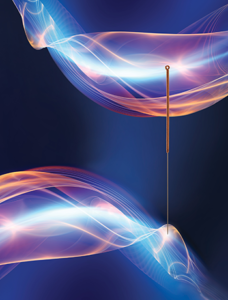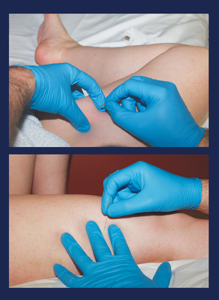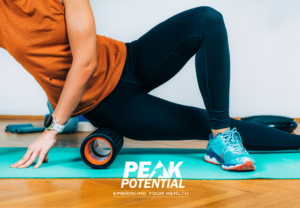As physical therapists, we are always looking for
new (or revisiting old) ways to help our clients
reach their goals. We work in many ways to
expedite the healing process and repair tissue.
One of our lesser known tools to reach these goals
is dry needling. We are going to answer some of
your questions today, so you can decide if dry
needling may benefit you.
What is dry needling?
This is a technique that uses a “dry” (meaning it
doesn’t inject any medication) thin needle inserted
into an area of muscle. This needle stimulates
trigger points, muscles, and connective tissues to
improve pain and movement problems.
It is effective in treating muscular tension and
spasms common to arthritis, nerve irritation,
muscle or ligament strains, and herniated discs.
With these conditions, there is usually a particularly
painful spot we can identify called a trigger point.
This is a taut band or “knot” within a muscle that
can cause pain. This pain can be local or refer to
other parts of the body. Dry needling deactivates
these pain points to restore joint movement, muscle
strength, and improve function.
By identifying the trigger of the pain, we are not
only addressing the symptoms, but also the root
cause. Additionally, as the needle helps release
and reset the muscle tissue, we are able to break
the pain cycle.
How is this different from Acupuncture?
If you have had acupuncture in the past, you will
notice we use the same sterile, thin filament needles.
However, Acupuncture is a practice based on
traditional Chinese medicine. The approach to the
body is in regards to energy flow and meridians.
The performance of dry needling by a physical
therapist is based on western medicine principles. It
is supported by strong scientific studies. In addition,
it utilizes the therapists thorough understanding of
the muscular, skeletal, and nervous systems. In our
clinic, this technique is not seen as a “cure”, but one
technique that is part of a larger treatment plan.
What kinds of studies support dry needling?
A recent study was conducted on patient’s with
chronic neck pain after whip last injury. These
patient’s previously responded poorly to traditional
exercise based physical therapy. The sensitivity and
severity of their injuries made it difficult to tolerate a
movement based treatment. Adding dry needling
to their treatment plan was found to speed up the
healing process, minimize pain and disability.
Consequently, there was a reduction in the overall
economic cost of treatment.
Are their any studies on athletes?
Well, I am glad you asked! A case report on female
volleyball athletes utilized dry needling therapy of the
shoulder during an intense competitive phase. As a
result, their range of motion, strength, and pain were
all improved post treatment.
Most importantly, they were able to continue their
overhead activities. Restoring muscle imbalances
while continuing to compete or train is important
to athletes. Treatments that require lengthy rest
or recovery periods are sometimes not an option.
In addition, dry needling is found to be a safe means to
improve physical performance. It reduces muscular
stress that accumulates from repetitive exercise and
diminishes muscle restrictions. Releasing these trigger
points allows a more coordinated sequence of the
muscles resulting in diminished injury, compensation,
and fatigue.
Let’s hear a patient’s perspective. . .
“The primary sensation during the process was
pressure. It was certainly worth it. The muscle
tightness, associated pain and limited mobility were
immediately improved. Muscles that I didn’t even
know were causing problems were much improved”
Our clients who undergo dry needling usually see
benefits in movement and pain right away. However,
several sessions are necessary to fully eliminate the
trigger point. Additionally, other therapy treatments
may also be necessary to retrain and strengthen the
muscles involved.
We believe dry needling will quickly become a poplar
drug free alternative to pain relief and improvement
of muscular performance.
Are you ready to see improved ease of movement and
decrease in your symptoms today? Request a call from
a physical therapist now at our website





